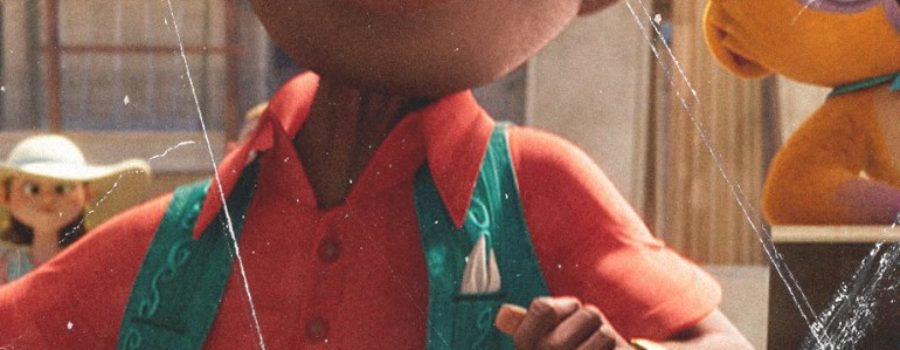[Published at Living Life Fearless] An animated musical feature taking place at the juxtaposition of tourist and Cuban cultures, with Lin-Manuel Miranda as a rapping, singing, and drumming procyonidae (more specifically, a kinkajou, or “honey bear”), Kirk DeMicco and Brandon Jeffords‘ Vivo is a film about preservation of cultural tradition through the universality of music and language via movement and rhythm, as evidenced by the close-knit relationships within its story. More specifically, that between Andres (Juan de Marcos González) and his former bandmate and lover, Marta (Gloria Estefan), Andres and his pet kinkajou (Vivo), and Vivo and Andres’ niece, Gabi (Ynairaly Simo in an excellent debut). Set against the backdrop of a beautifully animated Havana, Cuba, Andres, receives a letter from Marta, now famous, inviting him to her final concert in Miami, causing tension with his current, more furry, slightly less human bandmate, Vivo.
Vivo is begins with lost love separated by broken dreams, dwindling hope, and an ocean of regret. Andres’ tender love song is as beautiful and fleeting as the picturesque Havana sunsets. The songs, albeit slightly cliché, are undeniably toe-tapping and catchy, except for Miranda’s continuously tone-deaf rapping efforts, which began with the borderline minstrel show, Hamilton, proudly celebrating a country’s history of white supremacy across the United States for liberals and conservatives alike to unwittingly revel in. The story, however, becomes lost in a miasma of misanthropic misadventures and muddled social commentary.
Vivo is a film about preservation of cultural tradition through the universality of music and language via movement and rhythm
Perhaps the most interesting contrast is that of how Gabi’s immigrant family lives in Miami to how Cubans live in Havana. An abundance of brand new furniture, nice jewelry, material excesses such as toys, games, and electronic instruments, higher quality clothes, vast rooms with carefully curated décor. Alas, Vivo and Andres have considerably more modest living quarters, with noticeably less material belongings. One can notice a slightly off-kilter attempt to separate the embracing of capitalist and communist lifestyles amidst the United States’ and Cuba’s governments, with the characteristic old cars, architecture, and technology seemingly stuck in a time portal within the latter. There are no billboards, advertisements, or signs of corporate presence in the Havana we see. The music resonates off of the crumbling, gorgeous architecture, keeping the residents bustling in the town square outside of Andres and Vivo’s apartment. In Florida, however, residents seem content to be confined to the borders of their white picket fences in the suburbs.
Social Commentary
If there are lessons to be learned, Vivo shows us that one mustn’t hold love and passion inside, as they can flicker and slowly fade out like a burning wax candle, love comes in many forms, and nothing is permanent in this life. Through the character of the film’s namesake, meaning “alive” in Spanish, we realize second chances aren’t always guaranteed, and, sometimes, a dream doesn’t line up with reality. However, a dream can be carried down and realized through familial generations. In that sense, the main messages are endearing. However, they become watered down by narrative detours and a series of sociopolitical detours.
In Florida, we see plastic birds on lawns instead of real ones amidst a commendable commentary of capitalist destruction of endangered species, using the Girl Scout-adjacent “Sand Dollar Scouts” selling cookies, promoting the preservation of the environment, while enabling the very desolation of the environment. Girl Scouts, while a non-profit organization historically backing good causes like saving rainforest animals, not only uses child labor (tens of thousands of children) in Indonesia and Malaysia to obtain the palm oil necessary for their cookies, but the harvesting of this also creates fires, with workers bulldozing rainforests for palm oil plantations, endangering both wildlife and indigenous populations in said rainforests and beyond ― according to to a damning Associated Press report.
we see plastic birds on lawns instead of real ones amidst a commendable commentary of capitalist destruction of endangered species
While the Sand Dollars are well-intentioned, if ignorant, they represent an important device to create social commentary within Vivo. “We’ve let him run free, where he surely won’t survive,” proclaims their white leader (Katie Lowes), an ironic but insightful line. She wants to quarantine Vivo because it’s proper protocol, even though it may not be the best thing for him. In this instance, Gabi, a first generation Cuban-American, and Vivo, can be interchangeable to fit the film’s allegorical subtext. She’s a minority, and he’s an elusive, yet highly sought-after species. It’s equal parts an allegory for how we treat animals in zoos, and a heavy-handed and ham-fisted allegory for the state of immigration in the United States today. Many minorities, especially Latinos, as well as zoo animals and exotic pets like Vivo, are seen as a danger to themselves and others in the minds of the more conservative and oppressive citizens of this country.
The Sand Dollars, with rich parents (who own expensive boats), and their conservative-adjacent leader, proclaims Vivo doesn’t belong in the Everglades, while bossing around her minority friends (Lidya Jewett, Olivia Trujillo). The political undertones are especially fitting for a kinkajou, a species often hunted for pet trade, or for simply existing, and whose lifespan is significantly shortened under captivity. Even more so since the Everglades, a tropical rainforest, is an ecosystem in which Vivo would thrive. However, the film isn’t about fitting in where you come from or where you “should be” in the eyes of someone else, it’s about belonging in a place, a country that increasingly rejects immigrants, similar to invasive specifies such as Vivo, who the Sand Dollar leader proclaims must be locked up before he can enter. Sound familiar? The Sand Dollar leader also insists that Gabi act like her other minions and conform to rules she doesn’t agree with. Rules that simply aren’t fair to people like her.
Rough Patches
The adventure doesn’t begin until the second act, nearly halfway through Vivo, after much dialogue and narrative exposition, potentially losing its much-younger target audience. Even then, a well-meaning, but ultimately, cringeworthy inclusion of a suicide sub-narrative involving a daffy spoonbill (Brian Tyree Henry) who wants to die as a result of unrequited love, is both too mature for said target audience, as well as showing a fundamental lack of understanding of mental health issues. When the love is requited, the spoonbill sings about how his life is saved. Not only does this go against one of the film’s main lessons that love comes in more forms than solely romantic, but it also raises the issue that these types of explorations into mental health, if shown at all to such young viewers, should be crafted with more nuance.
Since Vivo has been a victim of the pet trade, an issue the film only halfway addresses, as he’s still seen as belonging to Andres and the girl, he is domesticated, and, sadly, won’t thrive as much as Miranda’s enthusiastic voice bolstering him implies. Still, beyond the muddled subtexts, Vivo learns that Andres lives on through his family, and that creating music can be something unifying. Uniting cultures, places, and people. Yet the film doesn’t take its time to hammer down this message, and the closure of the character arcs never seem fully realized. As such, the themes and lessons aren’t as impactful as DeMicco and company intend them to be. The finale unfolds in a hurried fashion, and Gloria Estefan’s voice is sorely lacking. A woefully underutilized Zoe Saldana and a painfully over-utilized Lin-Manuel Miranda further hamper this merely watchable animated musical.
Vivo will be available to stream on Netflix on 8/6.







![‘Paddleton’: Director Alex Lehmann On Rooting For The Underdog, Grief & Working With Ray Romano [Interview]](https://www.makingacinephile.com/wp-content/uploads/2019/02/Paddleton-movie-1200x520-300x200.jpg)
Leave a Reply
Your email is safe with us.